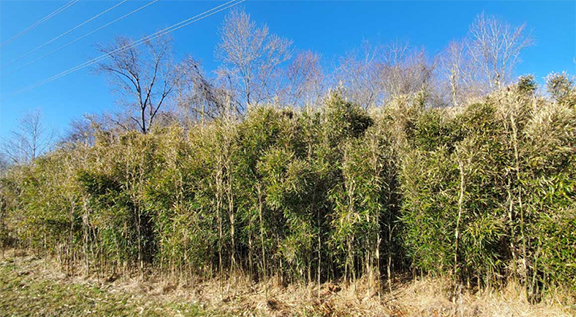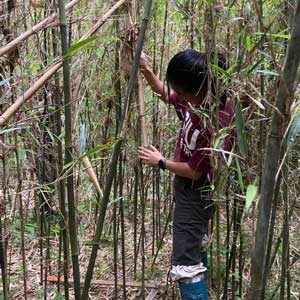by Tim Crosby
CARBONDALE, Ill. – Two researchers from Southern Illinois University Carbondale are studying the role remnants of a once common bamboo species plays in improving soil and water, supporting wildlife and the effects of nearby forests.

Researchers from Southern Illinois University Carbondale are studying the relationship between canebrake growth and forest characteristics, such as those seen in here, to assess the impact of forest canopy cover and the cane’s density, height and coverage area.
Jim Zaczek, professor of forestry in the School of Forestry and Horticulture, and Thanchira “M.J.” Suriyamongkol, a graduate student with SIU’s Cooperative Wildlife Research Laboratory, are studying giant cane, a woody perennial bamboo species native to the United States and found across 22 southeastern states from Maryland across Southern Illinois and eastern Oklahoma, and down to east Texas and Florida.
Using a grant from the Illinois Native Plant Society, along with support from the U.S. Department of Agriculture’s McIntire-Stennis Cooperative Forestry Program, the two are investigating the relationship between canebrake growth and forest characteristics, specifically assessing the impact of forest canopy cover and the cane’s density, height and coverage area.
The work could provide clues for better management of the species to improve its overall health and protect its important place in the ecosystem, including its role as a mitigator of agricultural runoff.
An iconic plant
Giant cane – or Arundinaria gigantea – historically has covered large swaths of the southeast. The plant typically grows densely on ground called “canebrakes,” a common sight in such areas.

Thanchira “M.J.” Suriyamongkol, a graduate student with SIU’s Cooperative Wildlife Research Laboratory, investigates a canebrake. (Photos provided)
Human activities, including land-clearing, agriculture, fire suppression, and livestock overgrazing, have drastically reduced its abundance. Scientists now believe that only 2% of canebrake habitat remains.
Previous studies indicate giant cane could be a good candidate as a riparian buffer species, especially against agricultural runoff, Suriyamongkol said.
“It improves soil and water quality, increasing soil infiltration rate and enhancing soil organic matter,” she said.
The plant also provides a habitat that supports diverse wildlife species of both vertebrates and invertebrates, though less is known about how Southern Illinois wildlife use it.
“In Southern Illinois, studies have been limited to species of concern, such as Swainson’s warbler,” Suriyamongkol said. “But we know it also supports a diverse wildlife community, with more than 70 species of wildlife observed using the canebrakes for nesting, feeding and more.”
The study is focusing on expanding scientists’ understanding of the animals that live amid giant cane, including birds, mammals, reptiles and amphibians in Southern Illinois, as well as the characteristics of canebrakes that contribute to animal habitat uses.
Field studies
To find out more, the researchers visited known cane patches and the areas surrounding them, looking for study sites. They ended up identifying 47 sites that met their criteria.
The researchers then took measurements of canebrakes, including height and density and area. They also examined nearby forest cover characteristics, such as tree density, area, tree height, leaf litter depth and canopy cover, along with the cover provided by other herbaceous plants and shrubs.
The researchers next used a model to look at the correlation between canebrake characteristics and the forest cover.
Results…
The researchers plan to publish their findings soon and are currently writing an article describing what they found. Suriyamongkol said those findings include cane growth being limited by nearby tree canopy topping the canebrakes.
“Based on the relationships between forest cover and canebrake characteristics that we observed, managing overstory trees through prescribed burning and/or thinning would promote cane growth,” she said.
Suriyamongkol said the work is important because the fragmented nature of canebrakes have made it difficult to determine their impact on the environment.
“Studying the remaining canebrake remnants could aid in determining their ecological value and resiliency,” she said. “Understanding canebrake status in association with forest cover could help guide management of canebrake to meet restoration goals by altering forest overstory conditions.”
